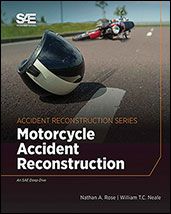Journal Article
Validation of Equations for Motorcycle and Rider Lean on a Curve
2015-04-14
2015-01-1422
Several sources report simple equations for calculating the lean angle required for a motorcycle and rider to traverse a curved path at a particular speed. These equations utilize several assumptions that reconstructionists using them should consider. First, they assume that the motorcycle is traveling a steady speed. Second, they assume that the motorcycle and its rider lean to the same lean angle. Finally, they assume that the motorcycle tires have no width, such that the portion of the tires contacting the roadway does not change or move as the motorcycle and rider lean. This study reports physical testing that the authors conducted with motorcycles traversing curved paths to examine the net effect of these assumptions on the accuracy of the basic formulas for motorcycle lean angle. We concluded that the basic lean angle formulas consistently underestimate the lean angle of the motorcycle as it traverses a particular curved path.


